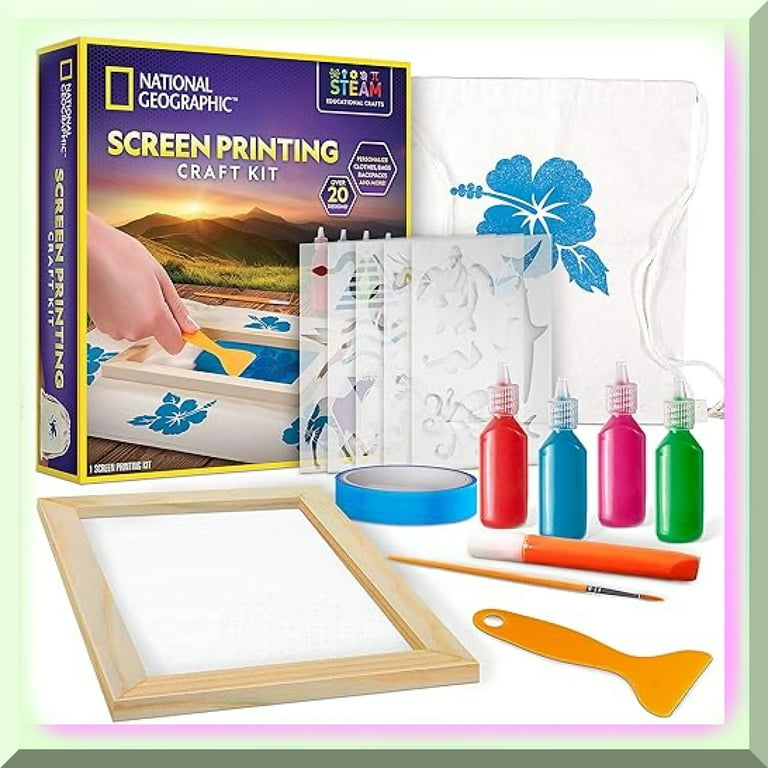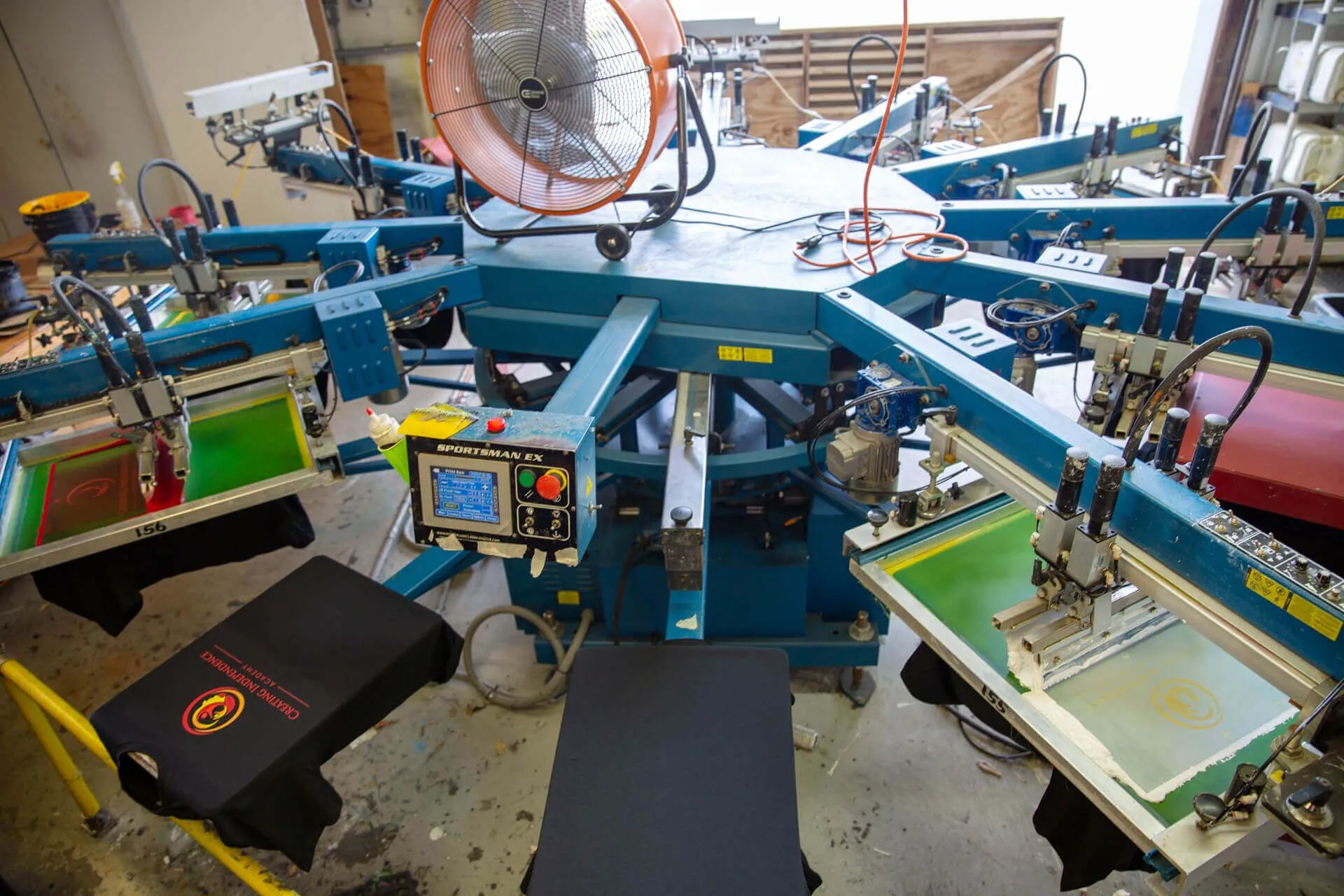Fast Turnaround Custom Screen Printing for Events
Wiki Article
Display Printing Uncovered: Everything You Need to Understand About T-Shirt and Garment Printing Methods
Screen printing is an interesting technique that integrates art with method, providing endless opportunities for creativity. Prepared to explore the necessary elements that make display publishing an art form?
The Basics of Screen Printing: Exactly How It Works
When you plunge into display printing, you'll find it's both a scientific research and an art. At its core, display printing involves developing a pattern, or display, that allows ink to pass via just in certain areas.Following, you'll blend your inks and prepare your printing surface. Setting the display over the fabric, then make use of a squeegee to press ink with the screen onto the garment. This procedure requires precision, as you want clear, lively prints. After printing, you'll cure the ink with warm, guaranteeing it sticks to the material and lasts through cleans. Each action is vital, and understanding them will boost your display printing abilities, changing straightforward garments right into one-of-a-kind, expressive pieces.
Sorts Of Display Printing Strategies
When you realize the fundamentals of display printing, it's time to explore the numerous techniques that can elevate your layouts. One preferred technique is traditional display printing, where ink is pushed via a stenciled screen.If you're aiming for great details, think about discharge printing. This method gets rid of dye from the textile, leaving a soft, classic appearance. Another option is plastisol printing, known for its toughness and vibrant shades, making it a favorite for numerous brands. Experiment with halftone printing to develop gradient effects and intricate designs. Each method has its unique charm, so do not be reluctant to try them bent on discover what fits your style best!
Necessary Devices for Display Printing
To achieve sensational outcomes in display printing, having the ideal tools is fundamental. You'll require a tough screen printing framework, which holds the mesh that transfers your design onto the garment. Next off, spend in top notch mops; these are important for applying ink equally throughout the screen.Choosing the Right Inks and Products
When picking inks and products for screen printing, you require to think about the sort of ink that works ideal for your task. Consider textile compatibility to ensure your styles look terrific and last long. Also, explore environment-friendly ink choices to make your printing procedure more sustainable.Sorts Of Display Inks
Choosing the ideal screen ink is vital for achieving vibrant, sturdy prints that satisfy your project's demands. There are several types of display inks to examine. Specialized inks, such as glow-in-the-dark or metallic, can add distinct results to your layouts.
Textile Compatibility Factors To Consider
Comprehending fabric compatibility is vital for achieving high-quality screen prints, especially since different materials react uniquely to various inks. When picking inks, take into consideration the material kind-- cotton, polyester, or blends. For cotton, water-based inks work well, using softness and breathability. Polyester, on the various other hand, often calls for plastisol inks for far better attachment and vivid shades. If you're publishing on blends, you may require to use a combination of both kinds. Constantly examine your inks on sample textile to assure they stick properly and preserve shade stability. Furthermore, remember that material weight and texture can impact the last outcome, so selecting the right ink and product combo is important for your project's success.Eco-Friendly Ink Options
Environment-friendly inks are coming to be a prominent choice for display printers who intend to reduce their ecological effect while preserving quality. When selecting inks, think about water-based inks, which are less dangerous and easier to cleanse up contrasted to typical solvents. These inks bond well with materials, delivering lively outcomes without poisonous chemicals. You might additionally check out eco-solvent inks that utilize less unpredictable natural substances (VOCs), making them a safer alternative for both your health and the planet.Additionally, try to find inks made from renewable energies, such as soy or vegetable-based choices. By picking the ideal inks and products, you'll not only produce sensational designs however additionally add to a much more sustainable printing procedure. Make the button, and your prints will show your commitment to the environment!
Preparing Your Design for Screen Printing

File Style Demands
To guarantee your layout looks dynamic and sharp on fabric, you'll need to pay close interest to submit format demands for display printing. Beginning with vector documents like AI or EPS, as they can be scaled without losing high quality. If you use raster pictures, select high-resolution files, such as TIFF or PNG, ideally at 300 DPI. Avoid utilizing JPEGs, as they can shed clearness when resized. Make sure your design has a transparent background to stop undesirable white edges on your prints. Finally, maintain color modes in mind; CMYK is conventional for display printing, so convert your RGB designs appropriately. By complying with these guidelines, you'll establish your artwork up for an effective print.Shade Separation Methods
Color separation is a vital action in preparing your layout for screen printing, and understanding it can significantly enhance your print quality. You'll need to break your design into specific shades, as each color needs a separate display throughout printing. This precision not only guarantees precise color representation but also simplifies the printing process.Resolution and Size
Accomplishing the finest lead to screen printing starts with assuring your design has the ideal resolution and dimension. Preferably, your artwork must go to the very least 300 DPI (dots per inch) for sharp, clear prints. Your last item could look pixelated and less than professional. if you make use of lower resolution.When it pertains to size, take into consideration the measurements of your print location. Design your artwork to match the last print size, preferably developing it in the real measurements you'll be publishing. This means, you'll avoid any type of unexpected scaling concerns.
Constantly examine your style in both vector and raster layouts. Vector graphics can be scaled without shedding quality, making them excellent for screen printing. Preparing appropriately will guarantee your style looks remarkable on every garment!
Step-by-Step Display Printing Process
Screen printing is a vibrant procedure that allows you to produce lively layouts on numerous surfaces. To obtain begun, you'll require a display, emulsion, and your picked ink. Initially, prepare your display by cleaning it completely. Next off, use the solution evenly and allow it completely dry in a dark area. As soon as dry, reveal your screen to light with your layout placed on it, which will certainly set the emulsion where the light hits, producing a stencil - screen printing kit.After washing out the unexposed solution, your screen is ready. Establish it up on your printing surface and align your garment beneath it. Put ink onto the screen and utilize a squeegee to press the ink through the pattern onto the textile. Lift the display carefully and allow the print completely dry. Lastly, treat the ink making use of warmth to guarantee sturdiness. That's it! You have actually successfully screen published your style.
Tips for Successful Screen Printing Projects
While you're diving right into your screen printing tasks, keep in mind that prep work is crucial to success. Begin by collecting all your products-- inks, displays, mops, and garments. A clean workspace assists avoid undesirable errors, so clean before you start.Next, validate your artwork is high-resolution and effectively sized for your garment. Evaluate your display for proper exposure and tidy it thoroughly to prevent spots. When mixing your inks, adhere to the maker's guidelines to attain the best uniformity.
Throughout printing, apply even stress with your squeegee for regular results. Don't hurry; take your time to confirm each print satisfies your requirements. After printing, let your garments dry totally before managing or packaging them.
Last but not least, always maintain an example of your work for future recommendation. In this manner, you can evaluate your development and enhance your techniques gradually. Pleased printing!

Frequently Asked Questions
Exactly how Lengthy Does It Take to Establish a Display Printing Work?
Establishing a display printing work generally takes about 30 mins to an hour. You'll prepare the displays, mix inks, and change the press. The time varies based on complexity and experience, so remain organized!Can I Publish on Various Fabric Enters Utilizing the Very Same Technique?
Yes, you can print on various material types making use of the exact same technique, yet you'll need to adjust your inks and setups. Some materials soak up ink in a different way, so experimenting warranties the most effective outcomes for every material.What Prevail Blunders to Stay Clear Of in Display Printing?
When screen printing, avoid usual mistakes like utilizing the wrong ink, ignoring appropriate direct exposure times, or missing pre-press checks. Always evaluate your setup and preserve clean displays to assure high quality results each time.How Can I Appropriately Tidy and Preserve My Display Printing Equipment?
To correctly clean and keep your screen printing equipment, you ought to on a regular basis wash displays with ideal solvents, examine mops for wear, and guarantee all tools are kept dry and dust-free. Consistency avoids costly fixings and boosts efficiency.Is Screen Printing Eco-friendly Compared to Other Approaches?
Display printing can be a lot more environmentally friendly than various other methods, especially if you use water-based inks and eco-conscious materials. By selecting sustainable supplies and methods, you minimize waste and minimize your influence on the earth.Screen Printing Uncovered: Whatever You Need to Know Concerning Tee and Garment Printing Strategies
At its core, display printing entails producing a stencil, or display, that permits ink to pass via just in specific areas. Placement the display over the textile, then utilize a squeegee to press ink with the screen onto the garment. custom screen printing One prominent method is typical display printing, where ink is pressed via a stenciled display.When picking inks and materials for display printing, you require to take into account the kind of ink that functions best for your job.
Report this wiki page